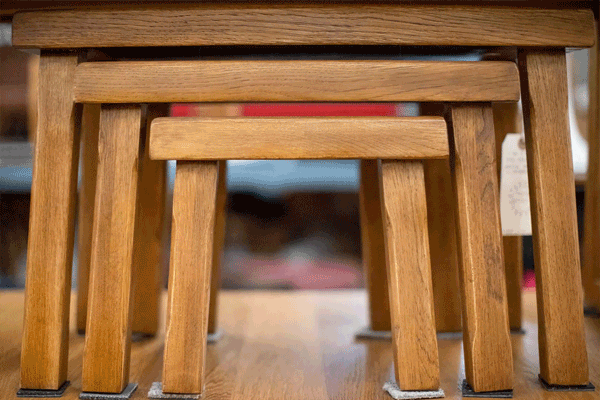Furniture gets distressed
Bonnie Cooper has seen plenty of slumps since she began selling furniture in 1968, but nothing like the scene outside the window of the Ontario sofa store where she now works.
Just across the parking lot lies an abandoned Levitz Furniture showroom and warehouse. A mattress store and two smaller furniture shops in the same outdoor shopping center also shut down recently.
“It’s scary out there,” said Cooper, a saleswoman at Salmo’s Custom Sofa. “I think this is the tip of the iceberg -- there’s more to come.”
As the housing market goes, so goes the furniture business. Such well-known brands as Levitz and Wickes Furniture have called it quits in recent months, liquidating their inventories. Others are struggling to hang on.
“This is one of the toughest periods we have seen in the last 30 or 40 years,” Farooq Kathwari, chief executive of Ethan Allen Interiors Inc., told Wall Street analysts in a conference call a few weeks ago. “A lot of our business has been diverted to these going-out-of-business sales.”
Analysts note that furniture is usually a discretionary purchase -- something that consumers can easily put off if they’re feeling the effects of the economic slowdown and the pinch of higher food and gas prices.
“If your refrigerator or car breaks, you have to replace it. If your furniture has a scratch, you can live with it for a while and replace it when times are better,” said Stefan Wille, president of Aktrin Furniture Information Center, a consulting firm.
Rising oil prices, which drive up the cost of gasoline for delivery trucks, foam for sofa cushions and other expenses, are also cutting into profits. Most of the industry’s trouble, however, is rooted in the sour housing market.
“As prices come down, people see their house less as a place they’d like to invest thousands of dollars,” said Laura Champine, who follows the furniture business for investment firm Morgan Keegan. “It seems like this is the deepest downturn since the early 1980s, maybe longer.”
The falloff in sales of new homes has also been a factor, cooling demand for the couches, tables, dressers and beds to fill them.
That trend is obvious in the Inland Empire, where a slew of furniture stores drew steady business serving new housing tracts in Ontario, Rancho Cucamonga and other communities near the 210 and 10 freeways.
Today, these developments are riddled with foreclosed and unsold houses.
At Salmo’s Custom Sofa in Ontario, Cooper said she noticed traffic in the parking lot begin to fall off about three years ago, about the time the housing market began to soften.
She sensed Levitz was in real trouble last year, when “they would run a humongous ad and [the turnout] would be pretty sparse. People were not responding,” she said.
Cooper said her own store, which sells only made-to-order sofas, might be faring better than others since it has a niche product and most customers are not new-home buyers. Still, she guesses sales are down about a third from a year ago.
Nationwide, consumer spending on furniture and bedding is projected to basically stall this year, gaining only 0.4%, according to a panel of industry analysts surveyed by the industry publication Furniture Today.
Those analysts predict furniture store sales will also be essentially flat this year, inching up to $65.7 billion from $65.2 billion last year.
By comparison, furniture store sales gained 2.1% in 2007 from 2006, with most of that increase coming in the first half of last year, analysts say.
Two of the industry’s biggest names are among the early casualties. In March, the 37-year-old Wickes chain began liquidating its inventory and closing its 43 stores.
Levitz, which was founded in 1953, began liquidating its 76 stores in December. The company had 21 locations in Southern California.
Analyst Champine believes other failures are ahead. Most vulnerable, she said, are small, privately owned firms in states such as California and Florida, where home price drops have been among the steepest in the nation.
Dolores Caffaro, who owns the three-store Pampa Furniture chain with branches in Sherman Oaks, West Hollywood and West Los Angeles, says she’s taking action to stay in business.
Along with the housing crash and rising fuel costs, Caffaro said, her business has been hammered by the falling dollar. The wholesale prices of furniture she imports from China and India have gone up 10% to 14% in recent months.
Caffaro said she decided in April to cut prices to boost sales volume.
“We’ve lowered our margins considerably,” she said, declining to specify how much.
Caffaro also turned the grim economy into a marketing tool, posting “Recession Sale!!!!” banners outside her stores.
Apparently, she’s convinced some that her pain can be their gain.
“Our volume is up 30% to 40% in April” compared with March, she said.
--
More to Read
Inside the business of entertainment
The Wide Shot brings you news, analysis and insights on everything from streaming wars to production — and what it all means for the future.
You may occasionally receive promotional content from the Los Angeles Times.









